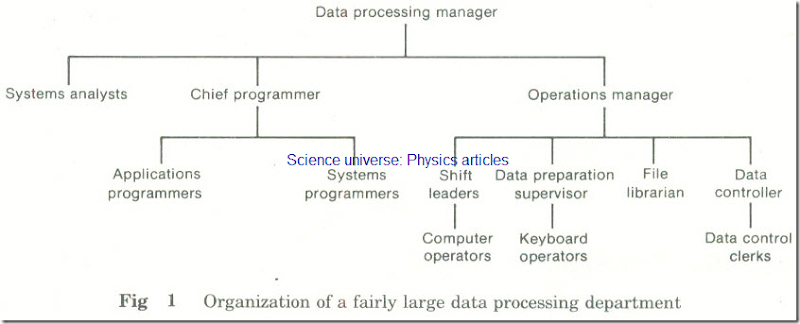JOBS IN COMPUTING
A very large number of people use computers as part of their work. This unit is about those people whose jobs are entirely concerned with computers and computing. Even here there is a wide variety of jobs. This variety has increased recently with the widespread use of microcomputers and networks. The situation is changing all the time.
For simplicity this unit describes the jobs of people working in a large installation. See Fig 1.) It is assumed that the department:
1 Designs and maintains much of the software itself.
2 Runs both a batch and a multi-access system.
In a smaller installation there would be fewer employees and some of the jobs would be combined together.
Fig 1 Organization of a fairly large data processing department
Data Processing Manager
The data processing manager (or DP manager) is the person responsible for the overall running of a data processing department. In a department too small to have a separate operations manager he/she is often known as the computer manager.
The OP Manager has responsibility for all aspects of the department’s work:
1 Design, production, and maintenance of programs.
2 Data preparation.
3 Reception and control of data.
4 Operations.
5 Hardware maintenance.
DUTIES OF A DATA PROCESSING MANAGER
1 Liaison with other departments about computing work to be done for them.
2 Allocation of duties and tasks to staff in the department.
3 Partial responsibility in employing new staff.
4 Meetings with staff to maintain the smooth running of the department.
5 Helping to decide general data processing policy and requesting equipment and other changes if necessary.
6 Keeping up to date with new developments in software and hardware.
7 Working out the cost of running the department.
Systems Analyst
A systems analyst is a person who analyses -an information system and considers the practicality of using computers to improve it. Usually if the analyst’s report is approved, he/she also designs and helps to implement the new system.
DUTIES OF A SYSTEMS ANALYST
1 Defining the client’s problem.
2 Analysis of the present system:
(a) Studying documentation of how the system should work.
(b) Observing how it actually works.
(c) Interviewing management and employees.
(d) Preparing a report:
(i) Defining inputs and outputs to the system.
(ii) Detailing the existing resources-hardware, software and people.
(iii) Describing the system with system flowcharts, etc.
3 Carrying out a feasibility study and producing a report:
(a) On making best use of existing resources.
(b) On software and hardware requirements of a new system.
Note: This work is carried out with full discussions, 80 that positive recommendations can be made with a good chance of acceptance.
If the report is accepted and the systems analyst is to be involved with design and implementation, then the work also includes:
4 Design of the new system including:
(a) Defining methods of data collection and preparation.
(b) Defining all clerical procedures and documents.
(c) The production of system flowcharts and program specifications.
5 If new programs are required then the system flowcharts are discussed with the chief programmer, so that program flowcharts can be prepared and the programming work allocated.
6 Providing user documentation for the new system .
7 Implementation of the new system. The analyst will probably be involved in:
(a) Designing test data and providing expected results for when it is used.
(b) Advising on the introduction of the new system:
(i) Training of staff.
(ii) Trial runs of the new system.
(iii) Easing the changeover from one system to the other.

